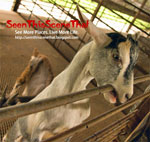
Mangrove Swamp Boardwalk: Pasir Ris Park
With the upgrading of the mangrove swamp boardwalk in Pasir Ris Park across Sungei Tampines from NTUC Downtown East completed recently, I brought my kids for a late afternoon walk at one of the few places in Singapore that’s available for a mangrove swamp boardwalk. This event took place before news broke that Pasir Ris Park beach had been declared unsafe for swimming and other water-based activities.
In the excitement to see a brand new mangrove swamp and boardwalk at Pasir Ris Park, we broke some rules pertaining to a visit to such a mangrove swamp park. Our constant loud refrain of ‘where are the mudskippers and fiddler craps?’ pierced the silence of the mangrove swamp. The clatter of our clogs on wooden boardwalk planks added to the auditory chaos. With squeaky bicycles pushed along the boardwalk, our totally noisy approach was hardly conducive to attract the inhabitants of the swamp to show their faces.
With the upgrading of the mangrove swamp boardwalk in Pasir Ris Park across Sungei Tampines from NTUC Downtown East completed recently, I brought my kids for a late afternoon walk at one of the few places in Singapore that’s available for a mangrove swamp boardwalk. This event took place before news broke that Pasir Ris Park beach had been declared unsafe for swimming and other water-based activities.
In the excitement to see a brand new mangrove swamp and boardwalk at Pasir Ris Park, we broke some rules pertaining to a visit to such a mangrove swamp park. Our constant loud refrain of ‘where are the mudskippers and fiddler craps?’ pierced the silence of the mangrove swamp. The clatter of our clogs on wooden boardwalk planks added to the auditory chaos. With squeaky bicycles pushed along the boardwalk, our totally noisy approach was hardly conducive to attract the inhabitants of the swamp to show their faces.

Fortunately, informative signboards scattered at regular intervals along the mangrove boardwalk brought some sense to our delirium. We picked up quite a number of learning points for our maiden visit to the newest upgraded mangrove swamp attraction in Pasir Ris Park. After we applied the recommendations as listed in the information boards, the sighting rate of mangrove inhabitants improved.
With a quieter scene, more patience and newfound knowledge of what to look for, the individual features in Pasir Ris Park’s mangrove swamp began to materialize out of the everything-also-look-the-same messy mud scene.

There were many features at Pasir Ris Park’s mangrove swamp worth seeing. I shall highlight just a few that piqued our curiosity.
Of the numerous residents of Pasir Ris Park’s mangrove swamp, we could only catch sight of a few inhabitants. Mudskippers, well camouflaged against the mud flats near the water’s edge were in abundance. If you wonder what visitors to do at a mud spa, come to the mangrove swamp boardwalk to see for yourself. The mudskippers appeared to be enjoying their mud spa treatment sessions, with full body and facial massage as they splayed on the mud pool.
Four-fingerbreadth-wide crabs were spotted upon movement of their pincers. They were busy feeding when we were there near dinnertime, but our rudimentary knowledge could not identify them with certainty. We witnessed a family with rods attempting to catch swamp fishes by leaning over the boardwalk railings. While fishes up to one-foot length in size could be seen sunbathing in the slightly murky waters, none of them swallowed the baits during our presence.
Piles of mud with gaping holes stood shoulder to shoulder along the perimeter of the swamp. These ‘mud mounds’ provide a good source of nutrition for life in the mangrove swamp. Restoration works to plant new mangrove plants were evident. These mangrove nurseries provide learning avenues for visitors to understand on-going efforts to keep the mangrove population alive and their inhabitants thriving.
The ubiquitous mangrove plants, standing on buttress roots that look like multi-legged supports, could not be missed in the dense green of trees and leaves. According to the information boards, mangroves provide dwelling spaces for many creatures living in the swamp. They are used for refuge, as food, as natural water filters and help to stabilize the coast.
A tower rises above the mangrove forest. For a partial bird’s eye view of the mangrove and for sightings of winged inhabitants, visitors should climb its approximately 4-storey high stairs. On this occasion when we visited, a group of teenagers had turned the tower into a private radio station with live music transmitting from their throats and guitars.
For first-timers going for a nature walk and sightseeing tour in Pasir Ris Park’s mangrove swamp, cycling on the mangrove boardwalk is prohibited. While the natural area is generally shady, a sunscreen lotion should be useful. Visitors should also bring along a good insect repellent to ward off mosquitoes. Other things on the good-to-bring-to-mangrove-swamp list would include umbrella or raincoat, cap, binoculars, camera and comfortable shoes.
Free car parking for 20 vehicles is available just next to the mangrove swamp, near NTUC’s Downtown East. You can also walk about 10 to 15 minutes to reach the mangroves from Pasir Ris MRT station and bus terminal near White Sands Shopping Centre. Otherwise, you can take SBS Bus number 403 from the bus-interchange and alight after one stop.
Useful Links:
1. Official National Parks Board Singapore website
2. Map and location of Pasir Ris Park mangroves
Recommended reading of my Pasir Ris themed posts:
1. Fishing and other pursuits in Pasir Ris Town Park
2. Pony Riding in Pasir Ris Park
3. Best Children’s Playground in Pasir Ris Park
1. Fishing and other pursuits in Pasir Ris Town Park
2. Pony Riding in Pasir Ris Park
3. Best Children’s Playground in Pasir Ris Park
See more places. Live more life.


 scene that
scene that


0 comments:
Post a Comment